Triacontatetragon
| Regular triacontatetragon | |
|---|---|
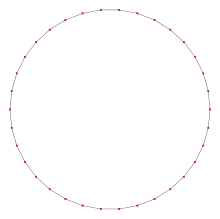 A regular triacontatetragon | |
| Type | Regular polygon |
| Edges and vertices | 34 |
| Schläfli symbol | {34}, t{17} |
| Coxeter diagram |
|
| Symmetry group | Dihedral (D34), order 2×34 |
| Internal angle (degrees) | 160+7/17° |
| Dual polygon | Self |
| Properties | Convex, cyclic, equilateral, isogonal, isotoxal |
In geometry, a triacontatetragon or triacontakaitetragon is a thirty-four-sided polygon or 34-gon.[1] The sum of any triacontatetragon's interior angles is 5760 degrees.
Regular triacontatetragon
A regular triacontatetragon is represented by Schläfli symbol {34} and can also be constructed as a truncated 17-gon, t{17}, which alternates two types of edges.
One interior angle in a regular triacontatetragon is (2880/17)°, meaning that one exterior angle would be (180/17)°.
The area of a regular triacontatetragon is (with t = edge length)
and its inradius is
The factor is a root of the equation .
The circumradius of a regular triacontatetragon is
As 34 = 2 × 17 and 17 is a Fermat prime, a regular triacontatetragon is constructible using a compass and straightedge.[2][3][4] As a truncated 17-gon, it can be constructed by an edge-bisection of a regular 17-gon. This means that the values of and may be expressed in terms of nested radicals.
Dissection
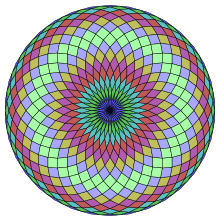
Coxeter states that every zonogon (a 2m-gon whose opposite sides are parallel and of equal length) can be dissected into m(m-1)/2 parallelograms.[5] In particular this is true for regular polygons with evenly many sides, in which case the parallelograms are all rhombi. For the regular triacontatetragon, m=17, it can be divided into 136: 8 sets of 17 rhombs. This decomposition is based on a Petrie polygon projection of a 17-cube.
 |
 |
 |
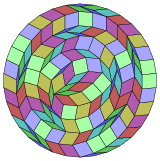 |
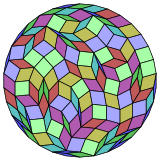 |
Triacontatetragram
A triacontatetragram is a 34-sided star polygon. There are seven regular forms given by Schläfli symbols {34/3}, {34/5}, {34/7}, {34/9}, {34/11}, {34/13}, and {34/15}, and nine compound star figures with the same vertex configuration.
 {34/3} |
 {34/5} |
 {34/7} |
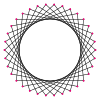 {34/9} |
 {34/11} |
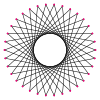 {34/13} |
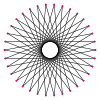 {34/15} |
Many isogonal triacontatetragrams can also be constructed as deeper truncations of the regular heptadecagon {17} and heptadecagrams {17/2}, {17/3}, {17/4}, {17/5}, {17/6}, {17/7}, and {17/8}. These also create eight quasitruncations: t{17/9} = {34/9}, t{17/10} = {34/10}, t{17/11} = {34/11}, t{17/12} = {34/12}, t{17/13} = {34/13}, t{17/14} = {34/14}, t{17/15} = {34/15}, and t{17/16} = {34/16}. Some of the isogonal triacontatetragrams are depicted below, as a truncation sequence with endpoints t{17}={34} and t{17/16}={34/16}.[6]
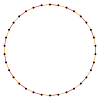 t{17}={34} |
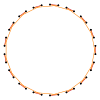 |
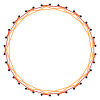 |
 |
 |
 |
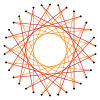 |
 |
 t{17/16}={34/16} |
References
- ↑ "Ask Dr. Math: Naming Polygons and Polyhedra". mathforum.org. Retrieved 2017-09-05.
- ↑ W., Weisstein, Eric. "Constructible Polygon". mathworld.wolfram.com. Retrieved 2017-09-01.
- ↑ Chepmell, C. H. (1913-03-01). "A construction of the regular polygon of 34 sides". Mathematische Annalen. 74 (1): 150–151. doi:10.1007/bf01455349. ISSN 0025-5831.
- ↑ White, Charles Edgar (1913). Theory of Irreducible Cases of Equations and Its Applications in Algebra, Geometry, and Trigonometry. p. 79.
- ↑ Coxeter, Mathematical recreations and Essays, Thirteenth edition, p.141
- ↑ The Lighter Side of Mathematics: Proceedings of the Eugène Strens Memorial Conference on Recreational Mathematics and its History, (1994), Metamorphoses of polygons, Branko Grünbaum